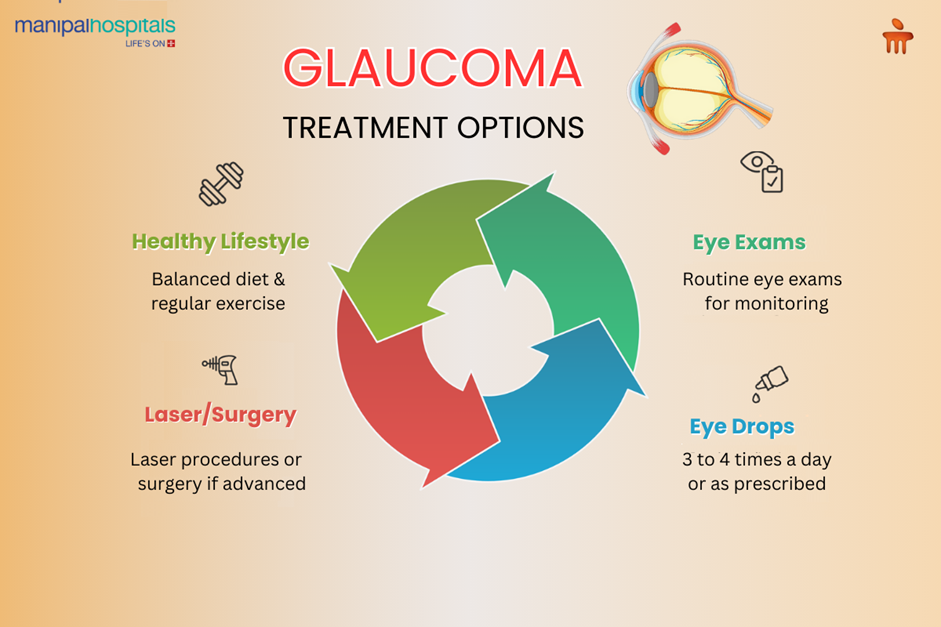
Glaucoma is a serious eye-condition which can be blinding if left undetected or untreated. The condition is typically caused by raised intraocular pressure. Most people don’t notice symptoms until the condition has progressed, so regular eye exams are crucial for early detection. In this blog a leading ophthalmologist in Bangalore explores glaucoma symptoms, disease origins, and available therapies to safeguard eye health over time.
Synopsis
What is Glaucoma?
Glaucoma is a serious eye condition often unnoticed until vision loss begins. Understanding its nature is the first step toward early detection and timely treatment. Here's a closer look at what glaucoma is:
-
Chronic Eye Condition: Glaucoma is a long-term eye disease that damages the optic nerve, often due to elevated intraocular pressure (IOP).
-
Silent Vision Loss: It usually begins by affecting peripheral vision and progresses silently over the years without noticeable symptoms.
-
Most Common Form: Primary Open-Angle Glaucoma is the most common type and develops gradually over time.
-
Rapid-Onset Variant: Angle-Closure Glaucoma is the second most frequent type and can appear suddenly with severe eye pain and discomfort.
Understanding Glaucoma Causes
Glaucoma develops due to various physiological changes and risk factors. While elevated eye pressure is a major risk, it doesn't cause glaucoma in every case, and normal pressure levels can also lead to the condition. Here are the main causes of glaucoma:
-
Genetic Factors: A strong family history of glaucoma increases the likelihood of developing the condition. It is essential for individuals with relatives (even if second degree relatives) having a history of glaucoma, to undergo regular screenings.
-
Idiopathic: glaucoma due to unknown or no identifiable causes.
-
Underlying systemic conditions: Long-standing hypertension or diabetes can cause ocular problems, resulting in glaucoma.
-
Vision Problems: Any vision problems, such as a high myopia (high minus power) or hypermetropia (high plus power) may also result in ocular changes leading to glaucoma.
-
Steroid Use: Use of corticosteroids, in any form (oral, topical application, eye drops, or inhalers), can raise intraocular pressure in patients who are steroid responders. Patients using steroids for any conditions should have their eye pressure monitored regularly.
-
Eye Injuries or Trauma: Previous eye injuries, even if minor, can lead to secondary glaucoma later in life. Trauma can cause internal damage, affecting fluid drainage and leading to pressure build-up.
-
Structural Abnormalities in the Eye: Anatomical issues such as narrow angles or underdeveloped drainage can disrupt the natural fluid flow in the eye, contributing to elevated pressure and optic nerve damage.
-
Underlying Eye Conditions: Conditions like uveitis, pigment dispersion syndrome, or retinal vein occlusion may also increase the risk of glaucoma by affecting the eye's internal pressure regulation.
How is Glaucoma Diagnosed?
Diagnosing glaucoma involves a comprehensive eye examination and a series of specialised tests suggested by an experienced ophthalmologist in Bangalore. Below are the primary diagnostic tests used to confirm glaucoma:
-
Tonometry: This test measures intraocular pressure. The most common method is Goldmann applanation tonometry, which involves applying a small amount of pressure to the eye’s surface using a specialised instrument.
-
Ophthalmoscopy (Fundoscopy): The doctor can examine the optic nerve for signs of damage or thinning. The appearance and colour of the optic disc can help assess the severity of glaucoma.
-
Perimetry (Visual Field Test): A visual field test maps out a patient’s peripheral vision. Since glaucoma affects side vision first, this test is crucial for detecting early vision loss patterns.
-
Gonioscopy: This involves using a special lens to examine the eye's drainage angle. It helps distinguish between open-angle and angle-closure glaucoma.
-
Pachymetry: This test measures the thickness of the cornea, which influences intraocular pressure readings. A thinner cornea may increase the risk of glaucoma.
-
Optical Coherence Tomography (OCT): OCT uses light waves to take detailed cross-section images of the retina and optic nerve, helping monitor nerve fibre loss and disease progression.
Living with Glaucoma: Tips for Long-Term Eye Health

Living with glaucoma requires a proactive approach to maintaining vision and managing eye pressure effectively. Adopting healthy lifestyle habits and following medical advice can significantly affect disease progression. Here are practical tips to manage glaucoma long-term:
-
Stick to Your Medication Routine: Regularly using anti-glaucoma eye drops as prescribed can keep intraocular pressure under control. Never skip doses and inform your doctor if you experience side effects.
-
Attend Regular Eye Check-Ups: Schedule follow-up appointments as recommended. These check-ups allow your doctor to monitor IOP and make necessary treatment adjustments.
-
Keep your associated systemic conditions under control: Proper control of hypertension or blood sugar levels can help reduce the risk of glaucoma.
-
Protect Your Eyes from Injury: Wear protective eyewear during activities that pose a risk of trauma. Even minor injuries can worsen glaucoma symptoms or trigger pressure spikes.
-
Follow a Healthy Diet: Incorporate leafy greens, antioxidant-rich fruits, in your diet. Though diet alone won’t cure glaucoma, it supports overall eye health.
-
Manage Stress: Practice relaxation techniques such as yoga, meditation, and breathing exercises for effective stress management.
Conclusion
Glaucoma is a serious but manageable eye condition. Early detection, understanding of its causes, and regular eye exams are crucial for preventing vision loss. While there's no cure, glaucoma treatment - ranging from medications to surgery - offers practical ways to preserve sight. Consistent monitoring and lifestyle changes can help people with glaucoma lead everyday lives.
FAQ's
Glaucoma cannot be cured, but early treatment can slow or halt vision loss.
Many people don’t experience noticeable symptoms until the disease is advanced.
Primary Open-Angle Glaucoma is the most common form, often developing gradually and without pain.
Yes, while more common in older adults, glaucoma can affect younger individuals, especially if there's a family history.
No, many cases are managed with eye drops. Surgery is typically considered when medications and laser therapies aren’t effective.





















 6 Min Read
6 Min Read













